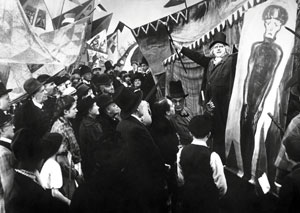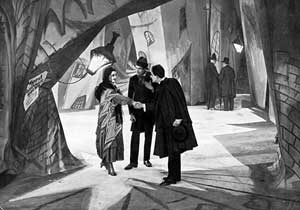http://www.stummfilm-silentmovie.de


Das Cabinet des Dr. Caligari (1919/20)
DARSTELLER: Werner Krauß, Conrad Veidt, Friedrich Fehér, Lil Dagover, Hans Heinz von Twardowski, Rudolf Lettinger, Elsa Wagner, Ludwig Rex zensurlÄNGE: 1780 Meter FORMAT: 35mm, restaurierte Fassung Musik: Gerhard Gruber
REGIE: Robert Wiene BUCH: Carl Mayer, Hans Janowitz KAMERA: Willy Hameister BAUTEN: Hermann Warm, Walter Reimann, Walter Röhrig MUSIK: Giuseppe Becce PRODUKTION: Decla-Film, Berlin | Der mysteriöse Schausteller Caligari führt in Holstenwall einen Somnambulen vor, der schreckliche Prophezeiungen ausspricht – und mordet. Manisch versucht Francis, den Tod seines Freundes aufzuklären. Er entlarvt den Schausteller als verrückten Direktor einer Irrenanstalt, der seine Patienten missbraucht. Doch die abschließende Rahmenhandlung zeigt Francis als Insasse der Anstalt. Mit dem gleichen zwielichtigen Blick, der den Schausteller einführte, schaut nun der Irrenhausdirektor auf ihn und murmelt, er wisse jetzt, was ihm fehle. Mit CALIGARI beginnt die Geschichte des expressionistischen Films. Bewusst stilambitioniert gestaltete Bilder wurden und werden als überzeugendes Beispiel für Filmkunst rezipiert. Dabei sind die Stilisierungen des Films eher vulgäre Anleihen, verglichen mit dem Expressionismus der bildenden Kunst. Leitprinzip ist, die schauerromantisch-phantastische Geschichte in verquere, dabei eingängige Bilddistorsionen zu übersetzen. Carl Mayer und sein Co-Autor Hans Janowitz hatten damit wenig zu tun. Sie hatten ein zwar plastisches und aktionsreiches, in der sprachlichen Präsentation noch recht konventionelles Drehbuch geschrieben. Als Ausstatter kam ihnen eher Alfred Kubin in den Sinn. Um Stil und geistige Urheberschaft des CALIGARI ranken sich viele Legenden. Seinem sensationellen Erfolg stand dies jedoch nie im Weg. english A German Expressionist film directed in 1920 by Robert Wiene, The Cabinet of Dr. Caligari is above all one of the most striking films of cinema. In effect, the film is the first and without a doubt the last cinematic work of art that 80 years later still arouses the passion of critics and analyses of film and art enthusiasts. It’s clear that the influence of the film extends well beyond its artistic and symbolic treatment, since its cinematic construction is reflected in a number of contemporary productions. The storyline is deceivingly simple. Caligari (Werner Krauss) is a hypnotist, who from fair to fair, shows off his attraction: a somnambulist named Cesare (Conrad Veidt) who blindly obeys him. When night falls, Cesare leaves the casket that shelters him for deadly sprees in the sleeping village. The first dimension of the film is eminently artistic, and The Cabinet of Dr Caligari is effectively a full fledged work of art. Looking at its context, Caligari was born in the heart of the modern art explosion, and particularly in German Expressionism. In reaction to the prominence of commercial Hollywood cinema (that, incidentally, doesn’t date from just yesterday...), German cinema opted for artistic positioning. This movement went on to father two other classics of the genre: Metropolis by Fritz Lang and Nosferatu by F.W Murnau—moreover one notes the resemblance between Cesare who sleeps in a coffin during the day and kills at night and the vampire Nosferatu. Robert Wiene called to the artists of the Der Sturm group (Röhrig, Rienmann & Warm) for the film set decor, combining Expressionist currents under the form of painting, architecture, as well as theatre. Everything of course is seen through the Expressionist eye of the camera. Each scene is a work of art and the film, in the same vein, a fresco composed of an ensemble of several works. Obviously, the film, as each scene, can be viewed and reviewed from a different eye, as one looks at a painting from an aesthetic point of view as well as a symbolic one—here the symbols abound and each passage merits analysis. So, one sees in the distorted and claustrophobic decor the influence of Expressionism and Cubism from industrial Germany as well as from artists like Edward Ludwig Kirchner, Lynel Feininger, Erich Heckel and Franz Marc among others. The film also has a political dimension. If the scriptwriter had at the base conceived the film as a critique of the blind power that had fathered World War I, Caligari symbolizing Prussian power and Cesare symbolizing its puppet people, the film escaped, as it were, its creators to become visionary. Expressionism, just as modern art, saw itself as the antithesis of realism, using art as a means of expression instead of as a banal rendering of reality. This Modernist movement opposed itself directly against the tendency of a rising Nazism trying to muzzle art as a means of expression.... Finally, this film has an incontestable cinematic influence. The Cabinet of Dr Caligari is cleverly manipulative on three levels. First it wins the spectator’s trust through its narrative form by asserting that what’s being shown is reality. While the realization is deceitful, it nevertheless conceals the revealing indices of another truth. The film challenges everything that preceded, ironically duping the spectator as crazy (an idea of producer Erich Pommer). Moreover, it was one of the first to demonstrate the manipulative aspect of film—a method that would be largely used in Nazi propaganda film. Finally, the film in a final, key scene brings ambiguity to the truth it just established, showing that madness is sometime closer to reality than one would at first allow. At this moment, one understands that the importance of The Cabinet of Dr Caligari defuses films as popular and original as The Usual Suspects, The sixth sense, Basic Instinct, as well as others by using the process that was first used by Robert Wiene. So, it’s urgent to see The Cabinet of Dr Caligari. More than being an art, movie, and history lesson, its permits one to not be duped by a Hollywood who does not hesitate to profit from a very short movie memory in order to recycle pioneer master works of cinema. http://filmmusik.at/ http://filmmusik.at/English/Gerhard-Gruber-Silentfilm-English.html http://filmmusik.at/Stummfilmpianist/Gerhard-Gruber-Stummfilmpianist.html Fred Thom |